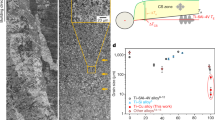Additive manufacturing is a process of producing parts, involving incremental addition of material onto a flat or axial substrate. This manufacturing option is also called ‘growth’ because the product is formed by continuously building up layers of material until it is complete. Additive materials and techniques are modern and relevant. Employing these techniques, materials can be produced with various types of energy to fuse powders. The structurization mechanism is virtually unknown in this case. Using additive manufacturing techniques, samples were prepared from the VT1-0 alloy powder on a VT20 alloy substrate and from the VT20 alloy powder on a VT1-0 alloy substrate. The structures of samples cut out from different areas of the deposited material were studied and their microhardness was measured. The relationship between the structure and microhardness in the deposited material was shown. A structurization mechanism for titanium material through the deposition of titanium powder was proposed. A mechanism for the formation of pores in the metal was suggested. The structurization process was characterized by the redistribution of doping elements in the deposited metal and the substrate, as evidenced by changes in microhardness. The microhardness varied from the level characteristic of the substrate metal to the microhardness inherent in the deposited metal. The temperature gradient during the growth of a metal sample was uneven. This led to changes in the size of the structural components in the metal. The powder was fused layer by layer, with the formation of pores depending on the powder particle size. Larger particles formed larger pores compared to those formed by finer powders. The processes established in the experiments were consistent for both deposition options. The difference resided in the base metal, specifically its chemical composition. The proposed mechanism enhanced the general understanding of the structurization processes during additive growth (deposition) of titanium alloys from their powders.








Similar content being viewed by others
References
A. A. Skrebtsov, Yu. I. Kononenko, and O. V. Lysytsia, “Structurization in additive deposition of titanium alloys,” in: Proc. III Int. Sci. Pract. Conf. Modern Science and Education: State, Problems, and Prospects [in Ukrainian] (March 20–21, 2023, Poltava, Ukraine), Vyd. Lugansk. Nats. Univ. Shevchenka (2023), pp. 432–433.
A. A. Dzhugan, A. V. Ovchinnikov, and V. E. Olshanskii, “Additive manufacturing techniques and capabilities of their application in modern conditions (overview),” Nov. Mater. Tekhnol. Metal. Mashinobud., No. 2, 96–101 (2014).
T. B. Yanko and A. V. Ovchinnikov, “Titanium in additive manufacturing techniques,” in: Collected Scientific Papers [in Russian], Pridnepr. Gos. Akad. Stroit. Arkhitekt., Ser. Strarobud. Chten., Issue 104, 217–222 (2018).
V. M. Nesterenkov, V. A. Matveychuk, and M. O. Rusynik, “Use of additive manufacturing electron-beam techniques for producing parts from VT1-0 titanium alloy,” Avtomat. Svarka, No. 3, 5–10 (2017).
B. V. Petrushchenko and A. A. Skrebtsov, “Studying the surface quality of billets produced by additive deposition,” in: Proc. Reports Sci. Pract. Conf. Science Week [in Ukrainian] (April 16–20, 2018), Zaporizhzhia National Technical University, Zaporizhzhia (2018), pp. 801–802 [https://zp.edu.ua/uploads/dept_s&r/2018/conf/1/TN2018.pdf].
Author information
Authors and Affiliations
Corresponding author
Additional information
Translated from Poroshkova Metallurgiya, Vol. 62, Nos. 7–8 (552), pp. 134–140, 2023.
Rights and permissions
Springer Nature or its licensor (e.g. a society or other partner) holds exclusive rights to this article under a publishing agreement with the author(s) or other rightsholder(s); author self-archiving of the accepted manuscript version of this article is solely governed by the terms of such publishing agreement and applicable law.
About this article
Cite this article
Skrebtsov, A.A., Kononenko, J.I., Lysytsia, O.V. et al. Structurization Mechanism in the Growth of Titanium Alloys. Powder Metall Met Ceram 62, 490–495 (2023). https://doi.org/10.1007/s11106-024-00410-y
Received:
Published:
Issue Date:
DOI: https://doi.org/10.1007/s11106-024-00410-y




